Quality Products for Vacation Entertainment
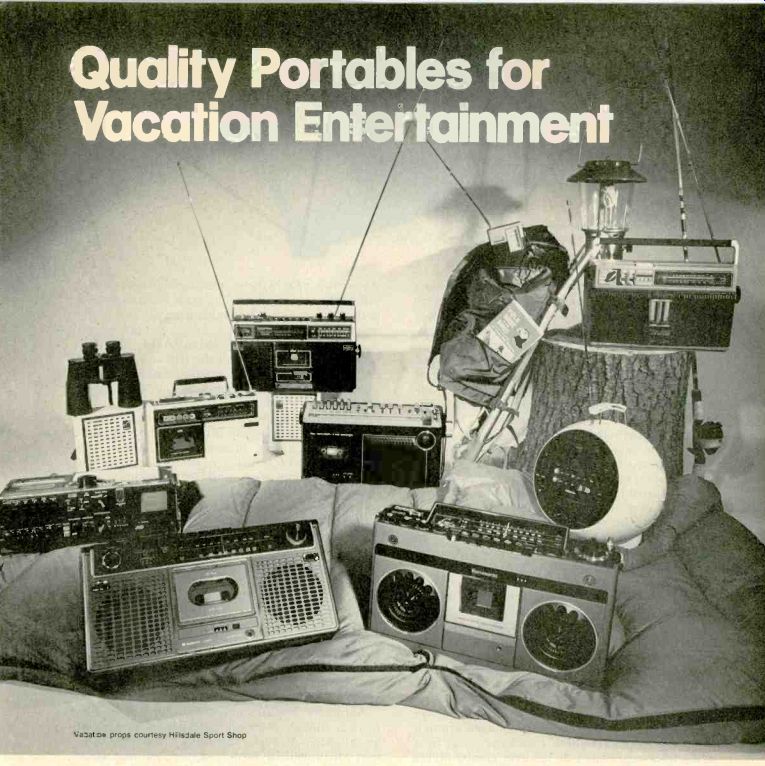
------- props courtesy Hilsdale Sport Shop
Better fidelity is available in all price ranges this year
by Stephen Traiman
WHEREVER YOU GO and whatever you do this summer, you can take some part of the world right along with you. Keeping pace with the trend to mobility-increasing, it seems, despite OPEC and shortages--audio (and video) equipment manufacturers have greatly expanded their lines of portables. Millions of us will be able to have far better sound than ever before in our cars, boats, and tents this year--and just about all the new hardware can be plugged into any AC you have available when you arrive wherever you're going, besides being powered by a built-in rechargeable battery pack or ordinary batteries.
When HIGH FIDELITY covered portable sound equipment seven years ago, the entries were relatively limited; multiband radios were just coming into their own and stereo cassette recorders new to the market. Today the range is vast, from the relatively low-cost eight-track player all the way to a giant twenty-four-band radio that pulls in the most remote shortwave (and long-wave) signals, and a three-in-one radio and cassette recorder with a built-in personal-size television screen. Better sound is available in all price ranges, and because of the end of fair-trade laws, there are better bar gains than ever.
------ Stephen Traiman, a new contributor to HIGH FIDELITY, is Tape/Audio/Video Editor of Billboard magazine. ------
Consider some of the developments in take-me-along units that could have been only dreams a few years ago: General Electric offers ten multiband radios, one ten-bander with FM, AM, public service, UHF; aircraft, shortwave, weather, and forty-channel CB monitoring. Panasonic counters with nine models in its military-look Tech series, topped by a twenty-four-band monster that includes SSB (single sideband) and VHF television reception--at $2,500.
Stereo is everywhere, in deluxe cassette tape recorders and eight-track players from a dozen or more manufacturers. Most feature stereo FM/AM radios and two-way speaker systems; several include noise-reduction capability and can double as home components. Some provide "stereo enhancement" to compensate for closely spaced built-in speaker pairs.

1. Emerson Radio P-4400;
2. General Electric Model 3-5531,
3. Bigston Model KSQ-1020;
4. Superscope Model CRS-152;
5. Pioneer Model RK-888;
6. Weltron Model 2010W;
7. JVC Model 3060;
8. Sanyo Model M-9950;
9. Panasonic Model RS-466S.
Eight-track recording, finding increasing acceptance in home compact and console systems, is offered in a futuristically styled globe from Weltron along with a stereo FM/AM radio.
A three-speed phonograph is available as part of a carry-along Voyager sound system that includes a cassette recorder and FM/AM radio-all in a compact attaché case that weighs only 12 pounds.
JVC, the first manufacturer to publicize the beefing up of its TV audio sections (via its "Hi Fi TV" campaign for three new portables last year), is equally progressive with its other portables. First it introduced the Model 3050 AM/FM/public service radio with built-in mini-TV and found the name--Gemineye--through a nationwide contest.
Now it is bringing out Model 3060, adding a cassette recorder. And in Japan, Sony has a similar unit, dubbed the Pacer, that also may show up here soon.
Under-dash car stereo systems have long offered "de-mountability" for use with an AC adapter or a DC battery pack-in fact, the alarming increase in auto-equipment thefts have made easy owner removal a necessity. Last year Nakamichi and ADS (Analog & Digital Systems) came up with the first component-quality car stereo system, and this year there is increasing emphasis on performance in more conventional automotive equipment.
Virtually every mono cassette or eight-track player with or without multiband radio offers bigger and better sound, many supplying the increasingly popular "sing-along" mike feature, mike mixing capability, and public-address adapt ability.
It's impossible to cover fully the astounding variety of portable products on the market, but this sampling of some of the more innovative and multifaceted models should give you an appetite-whetting idea of what's around for audio on the go.
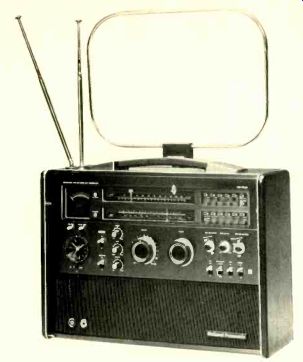
----------- Panasonic RF-8000 covers twenty-four bands from 150
kHz to 230 MHz. The radio tips the scales at about 50 pounds.
Multiband Radios
Almost any combination of bands imaginable is available in a long list of radio models from dozens of major manufacturers. The CB boom of the last few years has given rise to the inclusion initially of twenty-three- and now forty-channel reception capability, together with a variety of other useful bands. The moderately priced GE line of multiband units, for example, includes the Searcher (FM, AM, and public-service scanner for police, fire, other emergency calls), the Super 7 (FM, AM, PS, forty-channel CB, aircraft, weather, TV), and the top-of-the-line Model 7-2970 (a ten-band radio that adds to the foregoing a second public-service and two shortwave bands) for un der $120.
Panasonic, too, has an extensive array of multi-band models, ranging from around $50 to $2,500 for the RF-8000. Reminiscent of Grundig giants that have occupied hallowed places in many homes-initially in Europe and then in the U.S. the RF-8000 FM/AM/SSB/CB portable receiver covers all broadcast frequencies between 150 kHz and 230 MHz. Included are twenty-four bands, from long-wave to VHF-TV and aircraft, with a one-touch auto-drive selector switch. There is a beat-frequency oscillator to demodulate SSB and CW (continuous wave, used for Morse code) signals, automatic noise limiting and frequency control, squelch, and connections for stereo head phones, a mono earplug, auxiliary input, recording output, external speakers, AC power, and external VHF and SW antennas.
The Panasonic jumbo boasts twin oval speakers (7 by 4 inches) with separate bass and treble controls and built-in two-rod antenna, three ferrite core antennas, and a frame antenna. It is big (more than 20 inches) and close to 50 pounds hefty. As a portable, it requires eight D cells, plus a ninth for an electric clock and a tuning-fork battery.
Stereo Recorders / Players
Stereo is the big feature this season. There is a host of eight-track and cassette players and player / recorders available either as simple tape units or with a variety of multiband radio combinations.
The cassette is by far the most popular recording medium; the cartridge still is immensely popular in the U.S., particularly with the young music-buying crowd. It seems that the recording capability is less important to the average eight-track buyer than to his cassette-oriented counterpart, who may (among other things) want to use his portable equipment in conjunction with really high-quality home cassette gear, the likes of which don't even exist in the eight-track camp.
Among moderately priced (in the $150 range) stereo cassette decks are the new Bigston KSQ 1020 and the Sanyo M-9950. The Bigston has AC bias and erasure, one-touch cue/review, and a three-in-one meter that functions as a recording-level, battery-power, or tuning indicator, plus a variable monitor control during recording from radio, and a mixing switch for input from optional mikes. The Sanyo, actually a step down from Model M-9980 that offers twin two-way speaker systems with 5-inch woofers and 2-inch tweeters, includes two 5-inch full-range speakers, dual-function meter (showing recording level and battery charge), and a control to widen apparent stereo separation.
Among more deluxe models is the new top-of the-line Panasonic RS-466S with stereo FM/AM radio, twin 5-inch speakers, 6-dBW (4-watt) output power, lockable mechanical pause/cue/review controls, level/battery/tuning meter, and mike mixing. The unit has a sleep switch that doubles as an automatic timer, and a variety of jack pairs-for mikes, line-in, line-out, and external speakers, plus AC-in, DC-in, remote amplification, and headphones.
In the CRS-1800 stereo FM/AM radio recorder, Superscope has updated its CR-2000 with a mechanism that shuts off all modes of operation at the end of the tape. It features what the company calls "matrix stereo" enhancement-as opposed to the "discrete stereo" delivered by the separate amplifiers that drive optional external speakers that can be placed for best stereo imaging.
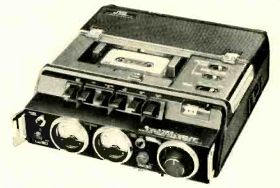
---------- JVC's Model KD-2 is a scaled-down professional-style
portable cassette deck that is suitable for on-location recording.
The new model is at the same moderately high price level (around $200) as the CRS-152, a unique portable that offers a condenser mike built into each of two detachable speakers to afford maximum separation in recording and playback. Both Superscope models offer four-way powering, including an optional rechargeable battery pack.
Moving up further in price and features, we find the Voyager Calypso imported by Keith Ian Company, in a compact (13 1/2 inches wide) package weighing just 10 1/2 pounds. Among its properties are a mono/stereo/stereo-wide switch (the last to enhance apparent separation), fully automatic shutoff, automatic level and frequency controls, an anti-beat feature for recording off the air, mike mixing, two built-in electret condenser mikes, plus AM, FM (including stereo), and two SW bands.
The Rolls-Royce category in battery-portable cassette equipment is, of course, the "professional" stereo deck for in-the-field use. HF has re ported on samples from Teac, Sony, Nakamichi, and JVC. JVC's KD-2, for example, incorporates that company's own Super ANRS noise reduction and Sen-Alloy head and operates for up to twelve hours on D cells (120-volt AC and 6-volt DC are us able as alternative power sources).
There is, again, nothing comparable in eight-track equipment. (Nor should you expect there to be since the technical limitations of the endless-loop cartridge are inherently more severe than those of the cassette.) The emphasis is squarely on price and convenience.
Emerson has introduced one of the real bargains (about $50) in the PT-95, replacing its original Su per 8 mono player. This compact (81/2 inches in its largest dimension) model has dual 3-inch speakers, lighted program indicators, and automatic and manual program change, and it operates on AC, batteries, or an optional 12-volt car/boat adapter.
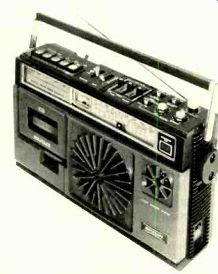
----------------
Model CR-3520, Superscope's top AM/FM radio/cassette recorder combination, offers full mixing and tape speed control.
GE's new eight-track model, 3-5531, features stereo FM/AM radio plus slider tone and volume controls, a stereo-enhancement switch, automatic/manual program advance, and a program repeat feature, plus twin 4-inch speakers and a moderate price-just over $100. At a somewhat higher price, you'll find the first of three Weltron futuristic globes, Model 2001. This stereo FM/AM radio-cum-eight-track player has two built-in 6-inch dynamic speakers, a semicircular, speedometer-style AM/FM station indicator, battery power indicator, and sliding controls for speaker balance, tone, and volume.
Striking again on the value front, Emerson offers the new PTR-505 stereo FM/AM radio and eight-track player. The stereo cartridge system provides pause, recording, fast forward, auto-stop, and program-selector controls, as well as an illuminated recording level meter, rotary micro phone mix control, and a quite satisfactory mike.
The newest of the Weltron globes, Model 2010, adds recording to Model 2001 from its radio, from a phonograph, or via the microphone. The 15-pound deck includes a battery-powered tuning/ recording-level meter, pushbutton tape controls, and sliding volume (left and right), bass, and treble controls.
"Big Sound" Playback
Virtually every new mono eight-track or cassette player features louder-and better-sound, meaning better clarity and fidelity, even at the low end of the price spectrum. Panasonic put its stamp on public consciousness by promoting its Dynamite 8 cartridge player using the talents of Jimmy (Good Times) Walker with his "dyn-o-mite!"; the Take 'n' Tape cassette player was added to the campaign as well.
GE is emulating that successful effort on behalf of its "big sound" portables, a line that began two years ago with the Loudmouth eight-track player with 6 1/2-inch woofer and 2.25-inch tweeter.
Showoff, an upgraded model incorporating AM/ FM radio, was joined by the Music Machine, including a cassette recorder and using a 6-inch woofer and "overdrive volume boost control" with a claimed "two times" output increase. All three models incorporate sing-along mikes and public-address capability.
Another new low-priced portable cassette recorder with FM/AM radio is the Panasonic RQ 516S. It has auto-stop, built-in condenser mike, sound monitor on/off switch, and AC/battery operation (6-volt DC or four C cells), plus a circular radio tuning dial with enlarging lens and a 3 1/2-inch speaker.
In the moderate price range ($130-160), a quartet of cassette recorder/multiband radios are particularly interesting. The JVC RC-515 offers FM, AM, and three SW bands plus a device that adds fine tuning of SW. Other features include a 6 1/2-inch dual-cone speaker, mike mixing, sleep switch, and a switch to eliminate beat noise while recording from radio. The Sanyo M-9600 has a 2 1/2-dBW (4-watt) amplifier, 6-inch dual-cone speaker, mike mixing with fader control, and public-address capability, in combination with an AM/FM/SW radio. It also has a three-way meter, ALC, AFC with defeat, auto-stop, and a memory digital tape counter and review function that provides automatic rewind and playback of any preset passage.
GE has six multiband radio/cassette combinations, but the initial model in its Monogram series is perhaps the most popular. Model 3-5250 plays and records from FM, AM, PS, aircraft, and weather bands and has a 4-inch speaker and multiple-function meter. It also provides a built-in electret condenser plus a remote mike for "sing along" function. The JVC RC-443 combines a 3 dBW (2-watt) power output with sound mixing, public-address capability, and a memory rewind, plus an oval speaker (6 by 9 inches) for both cassette play and reception from FM, AM, and two SW bands. Added versatility in mixing comes from an independent external mike level control, plus a mixing volume control.
In the higher price range are the new Centrex RK-888 from Pioneer of America and the Super scope CR-3520. The Pioneer has a stylish top-mounted control panel along with 43A-dBW (3-watt) power output and a two-way (6-inch woofer and 1 3/4-inch tweeter) speaker system. The recorder has a wide-range permalloy head, pause/ cue/review, memory rewind, and fully automatic stop.
Superscope's new top-of-the-line mono FM/AM radio/recorder also offers a two-way speaker sys tem: a 6-inch woofer and 2-inch tweeter. There is full mixing with a mike level control, a multipurpose meter, automatic stop, pause control, and sliding bass, treble, and volume controls. The radio section has FM muting and an LED tuning indicator.
"One-of-a-Kind" Units
The Voyager carry-along stereo sound system imported by Keith Ian, surprisingly moderate in price (under $200), is built into a trim 12-pound attaché case. Available with an AM/FM or AM/SW radio, the system includes attached oval (4 by 2 1/2 inches) speakers, a three-speed phonograph, and a cassette recorder sporting such features as a beat-cut filter and two mike jacks. The four-way power supply includes 120/220-volt AC, 6-volt DC, or battery (four D cells).
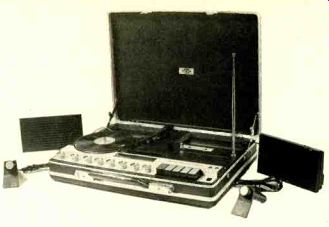
------- The Voyager portable stereo sound system from Keith Ian
fits neatly into ar attaché case and weighs a mere 12 pounds.
JVC's Model 3060 audio/video package offers a high-performance AM/FM radio with ceramic IF filters and a 43/4-inch speaker, plus a cassette recorder and tiny (3-inch diagonal) TV screen. The recorder features a sensitive built-in condenser mike, full mike mixing, automatic level control, tape-end stop, a multipurpose meter, simplified cue/review push tabs, and a sleep switch. The all channel TV has a unique switch that inverts the picture for easier viewing, and the compact, 11 3/4 pound unit operates on AC with built-in adapter or six D cells, an optional nicad rechargeable battery pack, or DC car/boat/plane systems.
At the very high end (around $700) of the portable market stands the Nakamichi/ADS car stereo system. Using the same transport found in the Nakamichi 500 and 550 decks, the top-load cassette player-only offers chrome/normal tape switching, Dolby, and a built-in preamp with volume, balance, and tone controls. Developed from the ADS 2001 speaker technology, the ADS 2002 also is a biamplified system with power amps built into the miniature (7 by 4 1/2 by 5 inches) speaker enclosures. Each has a super-long-excursion 4 inch woofer and a 1-inch soft-dome tweeter. An optional AC adapter brings the system indoors.
Attentiveness while buying portables could pay off in a more carefree trip or vacation. Check the warranty to determine whether it's "full" or "limited," as the new Federal Warranty Act clearly spells out the terms a manufacturer must meet.
Then test each function and operating mode fully before leaving on that first trip, to be sure that all systems are really go. And be sure to have that spare battery set, or sets, along-they always seem to go dead when you're far from a store, and nothing is more frustrating. Beyond that, with your choice from among the most extensive range of portables ever available, there should be little to do but enjoy.
(High Fidelity, May. 1977)
Also see: